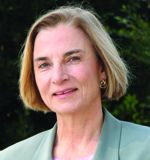June 2013

Patricia W. Finn, MD
It is a great honor and pleasure to write my first President’s Message for ATS News. During my presidential year, I plan to focus on questions of health equality and what the ATS can do to address these questions. Health equality is a broad topic. Promoting equitable health care is a mission embraced by multidisciplinary groups, clinicians, educators, and investigators from different educational backgrounds (e.g., MD, PhD, RN, MS, RT, PA), much like the composition of the ATS membership. In this message, I would like to touch on the role of nutrition in relationship to health equality. Good nutritional choices may not be options for those with limited resources. I am very appreciative of Michelle Obama’s efforts to increase awareness and accessibility of good nutrition, particularly to vulnerable populations. “Food deserts” (areas in which access to fresh foods is scarce) merit attention in clinical, investigative, and educational arenas. How might access to food that has nutritional value impact disease outcomes? A timely example is obesity, which is a current epidemic among children. Obesity rates are highest among those in the lowest socioeconomic levels. Reasons for the recent rise remain to be determined, but may include the presence of food deserts and the fact that processed and fast food is less expensive than fresh produce. New links between microbial populations that may be influenced by diet and obesity are under investigation. Analysis of the microbiome—the community of organisms that live on and in us—suggests that microbial populations in the body, including the lung, may affect disease outcomes. Studies in animal models and humans indicate that obesity and leanness are associated with different microbiome characteristics. Indeed, interest in the microbiome has sparked response from the National Institutes of Health, including the Human Microbiome Project and new funding opportunities. The 2013 Thomas L. Petty Aspen Lung Conference focused on “The Lung Microbiome: A New Frontier in Pulmonary Medicine.” Moreover, recent evidence showing an association with obesity and asthma is compelling. The concept “we are what we eat” is supported by data suggesting that diet/food choices influence and regulate our microbiome, furthering the link between nutrition and overall health. In the clinical arena we have an obligation to educate our patients about the influence of nutritional choices on health. Educating our trainees about the importance of practicing and communicating good nutrition is vital. In my own experience, trainees at all levels recognize the power of this message and are eager to engage in solutions. What can the ATS to do help?
- We can leverage our advocacy efforts on the local and national level to promote healthy eating.
- We can empower a “lung corps” of motivated students and trainees to tackle nutrition awareness from the perspective of the lung (more on lung corps in a future President’s Message).
- We can encourage collaboration in scholarly pursuits. Studies have shown the gut microbiome can influence the microbiome in other parts of the body. We can forge multidisciplinary approaches and collaborations with colleagues in epidemiology, molecular biology, bioinformatics, and other medicine specialties. The translational potential is tremendous.
As always, I welcome the input and suggestions of the members. I would also be grateful to hear your success stories and ways you are addressing issues of health equality, and in this case microbiome and nutrition related to the lung. Feel free to send an email to pwfinn@uic.edu.

